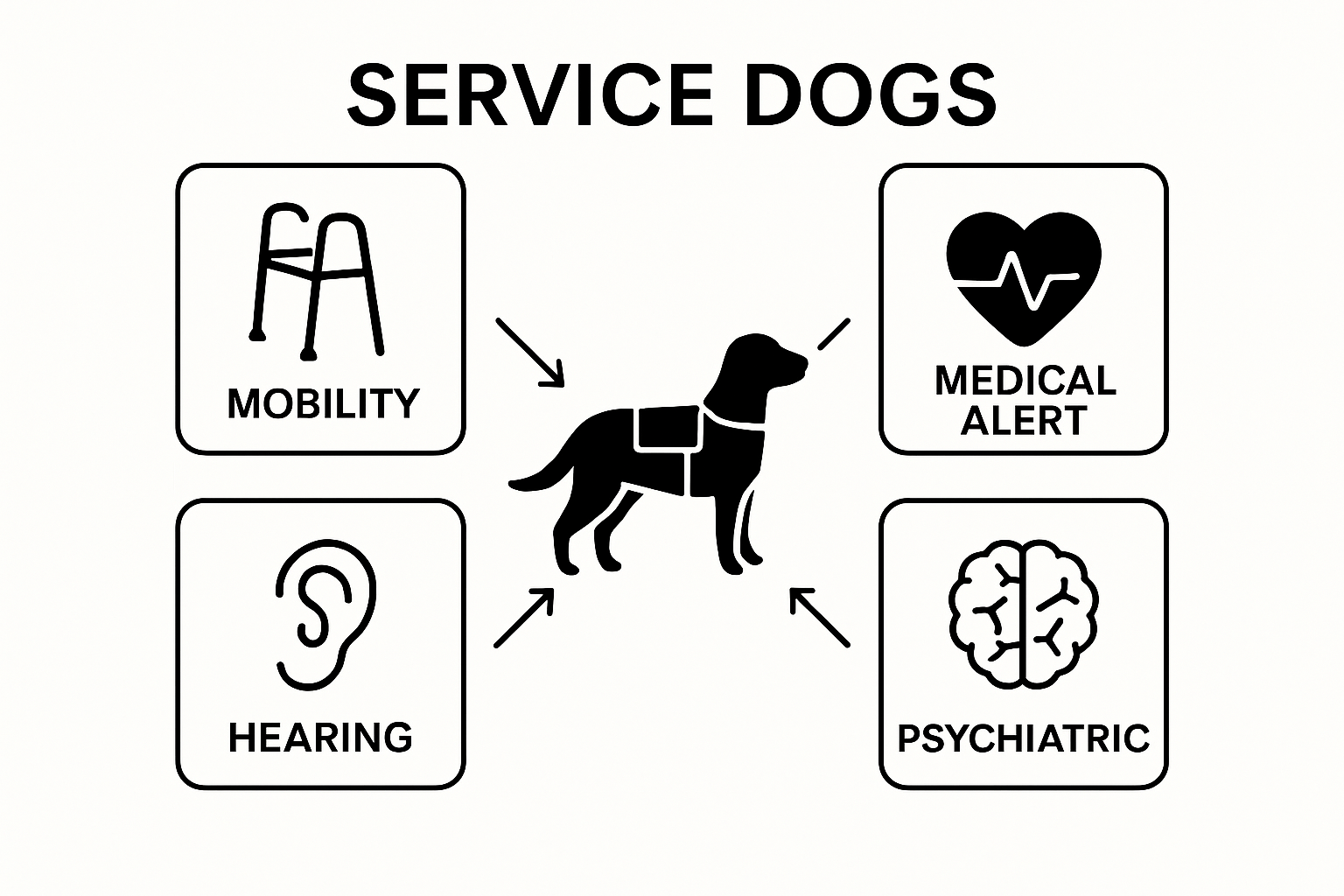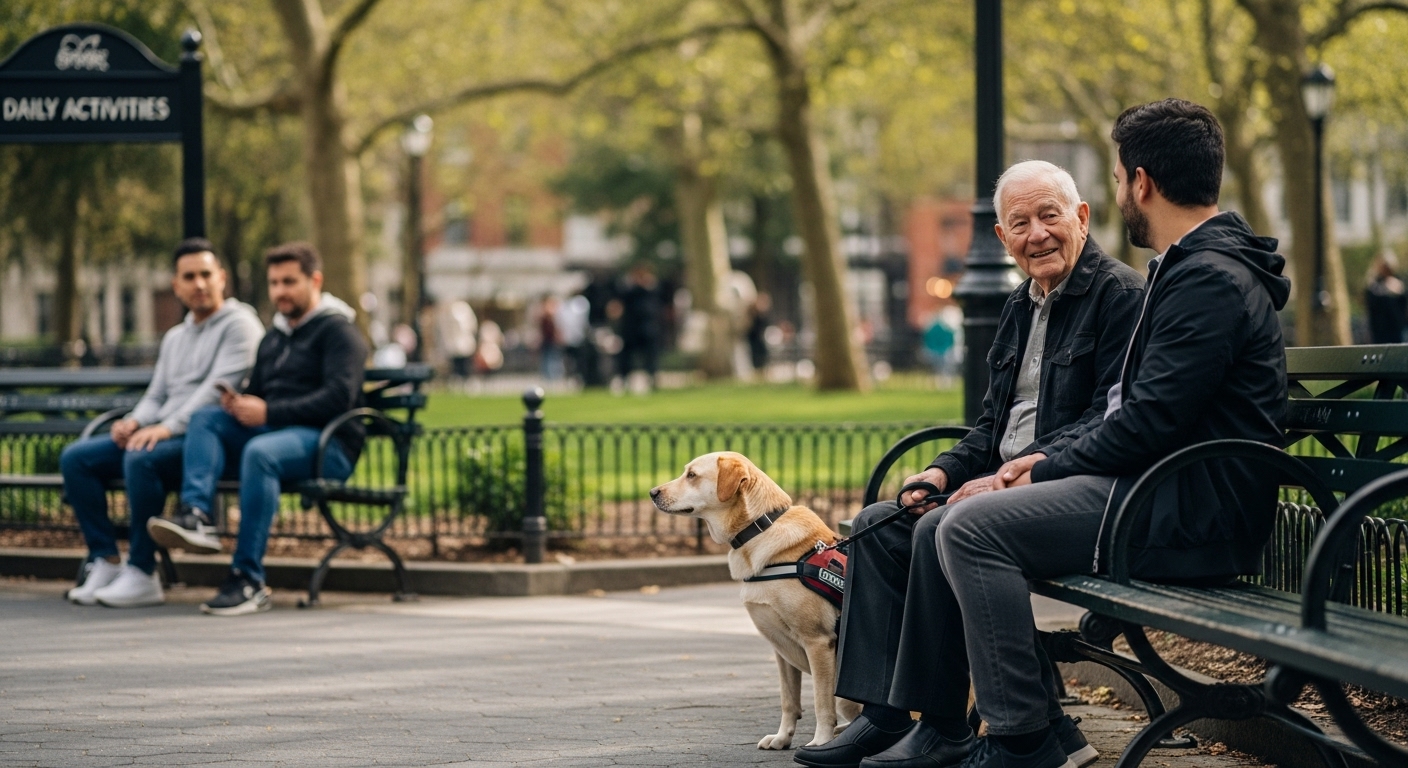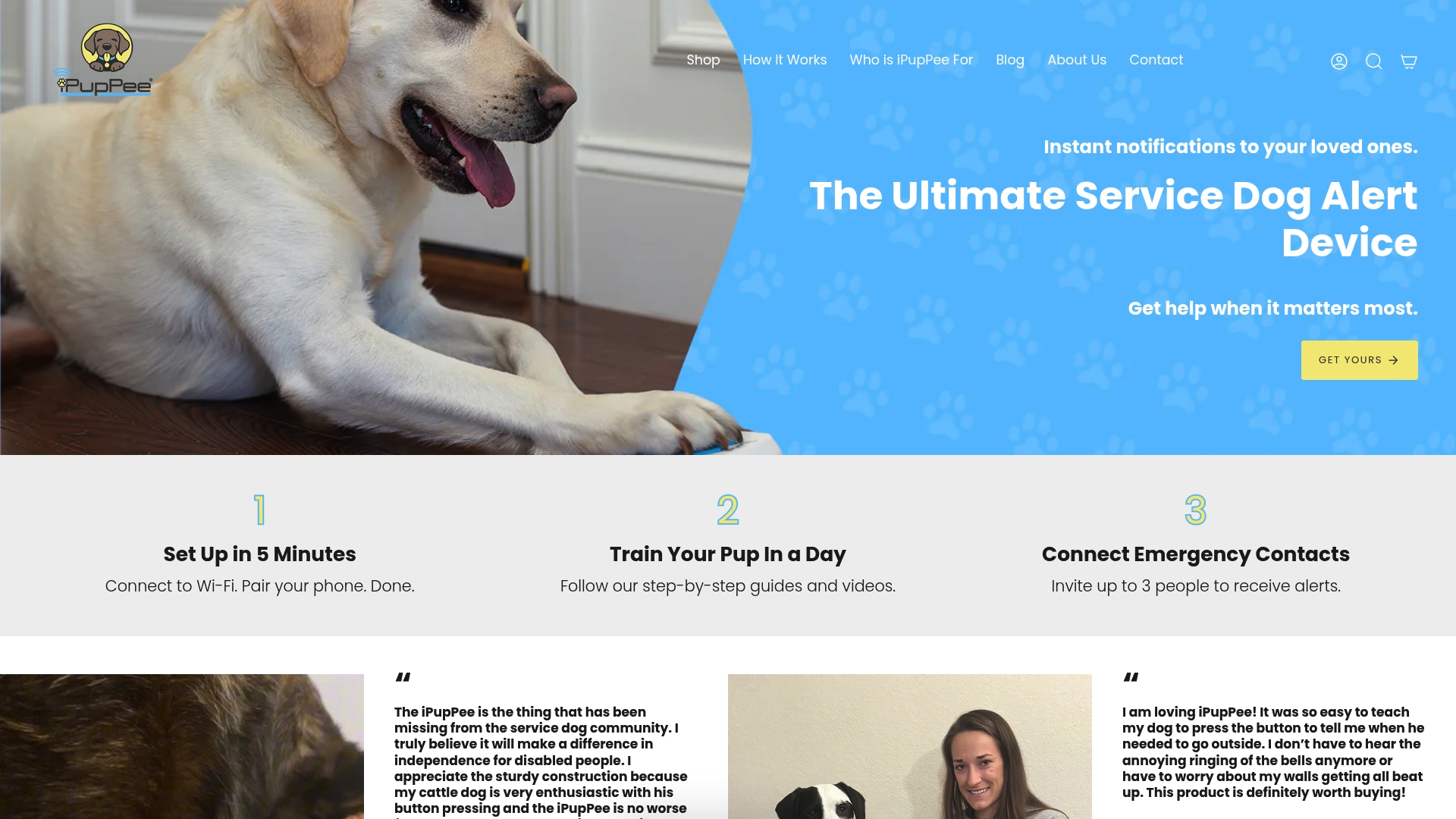Service dogs are changing daily life for seniors everywhere. Research shows these specially trained animals can reduce loneliness and spark up to a 30 percent improvement in emotional well-being. That alone seems impressive. Most people think their main job is to offer physical support and fetch things. The bigger surprise is how deeply they impact confidence, social engagement, and independence in ways no walker or cane ever could.
Table of Contents
- What Are Service Dogs And Their Roles?
- The Importance Of Service Dogs For Senior Citizens
- How Service Dogs Support Daily Activities
- Key Benefits Of Service Dogs For Seniors
- Real-Life Impact: Stories And Experiences
Quick Summary
| Takeaway | Explanation |
|---|---|
| Service dogs provide essential physical support. | They assist seniors with mobility challenges, helping with balance and navigation through everyday tasks. |
| Emotional well-being improves with service dogs. | Service dogs reduce feelings of isolation and loneliness, offering consistent companionship and support. |
| Service dogs enhance independence for seniors. | By assisting with daily activities, they help seniors maintain autonomy and self-sufficiency. |
| They can respond to medical emergencies. | Trained to recognize health issues, service dogs can alert handlers or call for help when necessary. |
| Real-life stories highlight their impact. | Testimonials illustrate how service dogs transform lives, providing both practical aid and emotional support to seniors. |
What Are Service Dogs and Their Roles?
Service dogs represent a specialized category of highly trained working animals designed to provide critical assistance to individuals with various disabilities, including seniors experiencing mobility challenges or specific health conditions. Unlike standard companion animals, these dogs undergo extensive professional training to perform specific tasks that directly support their handler’s daily functioning and independence.
Understanding Service Dog Classifications
Service dogs are not simply pets but professionally trained support animals recognized under the Americans with Disabilities Act. They are classified based on the specific type of assistance they provide, which can include:
Below is a table summarizing the main classifications of service dogs and the types of assistance they provide for seniors.
| Service Dog Type | Primary Role/Assistance Provided |
|---|---|
| Mobility Support Dog | Assists with walking stability, retrieving items, and navigation |
| Medical Alert/Response Dog | Alerts handlers to conditions such as seizures or diabetes |
| Hearing Assistance Dog | Helps individuals with auditory impairments detect sounds |
| Psychiatric Service Dog | Supports mental health needs, such as anxiety or depression |

- Mobility support for individuals with physical limitations
- Medical alert and response for conditions like seizures or diabetes
- Hearing assistance for individuals with auditory impairments
- Psychiatric support for mental health conditions
Key Characteristics of Service Dogs
These remarkable animals possess unique attributes that distinguish them from regular companion animals. Service dogs demonstrate exceptional skills, temperament, and training that enable them to work effectively in complex environments. They maintain professional focus during tasks, remain calm under pressure, and respond precisely to their handler’s needs.
For seniors, service dogs offer more than physical assistance. They provide emotional support, reduce feelings of isolation, and help maintain a sense of independence. Many seniors find that service dogs help establish daily routines and provide consistent companionship, which can significantly improve overall quality of life.
The relationship between a service dog and its handler is built on trust, mutual understanding, and specialized training. These dogs are not just helpers but dedicated partners committed to supporting their handlers through various life challenges.
This table highlights the key characteristics that differentiate service dogs from regular companion animals, especially in supporting seniors.
| Characteristic | Description |
|---|---|
| Specialized Training | Undergo extensive training to perform specific support tasks |
| Professional Focus | Remain attentive and focused while working in varied environments |
| Calm Temperament | Stay composed under pressure and adapt to their handler’s needs |
| Emotional Support | Reduce isolation and provide consistent companionship |
| Reliable Task Performance | Complete complex and essential activities for their handler |
The Importance of Service Dogs for Senior Citizens
Service dogs represent a transformative solution for senior citizens facing physical limitations, emotional challenges, and independence concerns. These highly trained animals go beyond traditional companionship, offering comprehensive support that significantly enhances quality of life and personal autonomy.
Physical Support and Mobility Assistance
For seniors experiencing mobility challenges, service dogs provide critical physical support. These remarkable animals are trained to help with tasks that might otherwise become difficult or impossible. They can assist with walking stability, retrieving dropped items, opening doors, and helping their handlers navigate complex environments. Learn more about how dogs support senior independence.
The physical benefits extend beyond immediate task assistance. Service dogs encourage regular movement, gentle exercise, and outdoor activity, which are essential for maintaining senior health. Their presence motivates older adults to stay active, reducing the risk of sedentary lifestyle complications.
Emotional and Mental Health Benefits
Beyond physical support, service dogs offer profound emotional and psychological advantages. According to research from Frontiers in Veterinary Science, these animals significantly reduce feelings of isolation and loneliness, which are common challenges for seniors.
The emotional connection with a service dog can provide:
- Consistent companionship and unconditional support
- Reduced symptoms of depression and anxiety
- Increased social interaction and communication opportunities
- Enhanced sense of security and confidence
Safety and Emergency Response
Service dogs are trained to recognize and respond to potential medical emergencies. For seniors with conditions like diabetes, heart issues, or seizure disorders, these dogs can provide life-saving interventions. They can alert handlers to dangerous health changes, retrieve medical equipment, or even contact emergency services when needed.
The partnership between a senior and their service dog is built on trust, mutual understanding, and specialized training. These dogs are not merely assistants but dedicated companions committed to enhancing their handler’s independence, safety, and overall quality of life.
How Service Dogs Support Daily Activities
Service dogs transform daily living for seniors by providing comprehensive assistance that extends far beyond traditional companionship.
These highly trained animals become essential partners in maintaining independence, safety, and quality of life through targeted support across multiple functional domains.
Essential Home and Personal Care Tasks
In home environments, service dogs perform critical tasks that help seniors navigate daily challenges. Check out our detailed guide on service dog daily tasks to understand their remarkable capabilities. These dogs can assist with complex activities such as:
- Retrieving medications
- Helping with clothing and dressing
- Opening and closing doors
- Turning light switches on and off
- Picking up dropped items
According to research from the Americans with Disabilities Act, service dogs are specifically trained to perform tasks directly related to an individual’s specific needs, ensuring personalized and precise assistance.
Mobility and Navigation Support
For seniors experiencing mobility limitations, service dogs provide crucial physical support during movement. They help handlers maintain balance, navigate complex environments, and provide stability while walking. These dogs are trained to walk at a specific pace, adjust to their handler’s mobility constraints, and offer physical support through specialized harnesses.
Beyond physical assistance, service dogs help seniors maintain confidence and reduce the fear of falling. Their presence allows older adults to move more freely and independently, potentially reducing the need for additional mobility aids or constant human assistance.

Safety and Emergency Response
Service dogs are extraordinary in their ability to recognize and respond to potential medical emergencies. They can detect subtle changes in their handler’s physical condition, alert to approaching health risks, and even contact emergency services when necessary. For seniors with conditions like diabetes, heart issues, or seizure disorders, these dogs serve as living medical alert systems.
The relationship between a senior and their service dog transcends traditional assistance. These animals provide a unique combination of practical support, emotional comfort, and a sense of security that significantly enhances overall quality of life.
Key Benefits of Service Dogs for Seniors
Service dogs represent a transformative solution for seniors, offering multifaceted benefits that extend well beyond basic physical assistance. These remarkable animals provide comprehensive support that addresses physical, emotional, psychological, and social dimensions of senior well-being.
Physical Health and Mobility Enhancement
For seniors experiencing mobility challenges, service dogs serve as dynamic support systems. They help maintain physical activity, reduce the risk of sedentary lifestyle complications, and provide essential stability during movement. Explore our comprehensive guide on service dog benefits to understand their profound impact.
The physical benefits include:
- Improved balance and walking stability
- Enhanced motivation for regular exercise
- Reduced risk of falls and related injuries
- Increased independence in daily activities
According to research from Purdue University, these dogs significantly improve psychosocial health by enhancing overall physical functioning and emotional well-being.
Emotional and Psychological Support
Beyond physical assistance, service dogs provide critical emotional support for seniors. They help combat feelings of isolation, reduce symptoms of depression, and offer unconditional companionship. The psychological benefits are profound, creating a sense of purpose, connection, and emotional security.
Service dogs help seniors by:
- Providing consistent emotional comfort
- Reducing anxiety and stress levels
- Creating opportunities for social interaction
- Maintaining a sense of purpose and routine
Social Engagement and Independence
Service dogs act as powerful catalysts for social interaction and community engagement. They help seniors maintain social connections, encourage outdoor activities, and provide a natural conversation starter. The presence of a service dog can help break down social barriers, making seniors feel more confident and connected to their community.
Moreover, these dogs significantly enhance seniors’ sense of independence.
The following table provides an overview of the major benefits that service dogs bring to seniors across physical, emotional, and social domains.
| Area | Example Benefits |
|---|---|
| Physical Health & Mobility | Improved balance, stability, and encouragement of activity |
| Emotional & Psychological Support | Reduced feelings of loneliness, anxiety, and depression |
| Social Engagement & Independence | Increased social interaction and sustained autonomy |
| Safety & Emergency Response | Alerting to medical issues and retrieving necessary equipment |
| By assisting with daily tasks, providing medical alerts, and offering constant support, service dogs help seniors maintain autonomy and self-sufficiency, ultimately improving their overall quality of life. |
Real-Life Impact: Stories and Experiences
Service dogs transform lives in ways that extend far beyond theoretical descriptions. Real-world experiences reveal the profound and nuanced ways these remarkable animals support seniors, offering insights into their extraordinary capabilities and deep emotional connections.
Personal Independence and Empowerment
Personal stories highlight how service dogs become true partners in maintaining independence. Learn more about service dog experiences and understand the depth of their impact. Seniors frequently report significant improvements in daily functioning, with service dogs enabling them to:
- Navigate complex environments more confidently
- Perform tasks previously challenging or impossible
- Reduce reliance on human assistance
- Maintain a sense of personal agency
According to research from the National Institutes of Health, individual narratives demonstrate how service dogs provide more than physical support they restore a sense of dignity and self-determination.
Emotional Resilience and Connection
Beyond practical assistance, service dogs offer profound emotional support. Many seniors describe their service dogs as lifelines during challenging periods of isolation or health transitions. These animals provide consistent emotional presence, helping seniors navigate complex emotional landscapes.
Emotional benefits reported by seniors include:
- Feeling less lonely and isolated
- Experiencing unconditional companionship
- Developing a sense of purpose
- Maintaining motivation during health challenges
Transformative Personal Narratives
Personal stories reveal the transformative power of service dog relationships. Some seniors describe their service dogs as more than assistants they are trusted companions who understand their unique needs. These narratives often highlight moments of unexpected connection, subtle communication, and mutual understanding that transcend traditional human-animal interactions.
Each service dog relationship is unique, reflecting the individual needs and personalities of both the handler and the dog. These stories underscore that service dogs are not just trained animals but empathetic partners committed to supporting seniors through life’s complex journey.
Give Your Service Dog a Voice and Strengthen Independence at Home
You have learned how service dogs help seniors with daily tasks and bring peace of mind through support and companionship. But what if you could make communication between you and your service dog even faster and safer? Many seniors worry about emergencies or not being able to signal for help on their own. The iPupPee alert device was built with these real-life challenges in mind to make life at home safer and more independent for both you and your loyal companion.

Transform the way you connect with your service dog. Visit ipuppee.com to discover how the iPupPee can help you strengthen communication and enhance your daily safety. See customer stories, learn easy training tips, and shop today to give your dog the tools to protect and assist you when it matters most.
Frequently Asked Questions
What types of disabilities can service dogs assist seniors with?
Service dogs can assist seniors with various disabilities, including mobility challenges, medical conditions such as diabetes or seizures, auditory impairments, and mental health issues like anxiety and depression.
How do service dogs help improve the emotional well-being of seniors?
Service dogs provide companionship, reduce feelings of isolation, offer unconditional support, and increase opportunities for social interaction, which can significantly enhance emotional well-being for seniors.
What tasks can service dogs perform to assist seniors in their daily lives?
Service dogs can help seniors with tasks such as retrieving medications, providing stability while walking, opening doors, turning on lights, and alerting handlers to medical emergencies.
How do service dogs enhance the independence of seniors?
Service dogs enhance the independence of seniors by providing physical assistance for mobility, performing daily tasks, and offering emotional support, ultimately helping them maintain autonomy and confidence in their daily activities.

